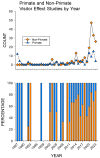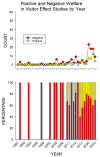Animal-Visitor Interactions in Zoos and Aquariums: A Systematic Review
- PMID: 40646823
- PMCID: PMC12248964
- DOI: 10.3390/ani15131924
Animal-Visitor Interactions in Zoos and Aquariums: A Systematic Review
Abstract
There is increasing recognition of the importance of human-animal interaction (HAI) research in the assessment of animal welfare. This is partly reflected by the appearance of increasing animal-visitor interaction (AVI) publications in zoos. Early AVI publications primarily focused on primates and the impact of visitors on animals (visitor effects), with most identifying negative welfare impacts. This review aims to identify trends and changes in the key factors of AVIs (e.g., types of interactions measured; taxa studied; welfare impact). Covidence online software and PRISMA were used to screen papers and extract data. A total of 157 papers comprising 314 studies were included. AVI publications have increased in the last two decades, with a large increase in publications since 2020. Most publications have focused on visitor effects, as opposed to the impact of animals on visitors (visitor experiences). Earlier visitor effect studies mostly focused on primates, while more recent studies have primarily focused on non-primate species. Excluding studies categorized as neutral, there were more visitor effect studies with measures focused on negative than positive welfare impacts. However, the last decade and a half has seen a substantial increase in visitor effect studies measuring positive welfare impacts. These results are discussed in reference to growing changes in the types of studies, species, and outcomes measured in AVIs. In addition, we consider the future of AVI research, including a growing need for and consideration of standardized welfare assessments, the increased use of experimental control, and AVIs that equally promote visitor education and positive animal welfare.
Keywords: animal-visitor interactions; aquariums; human-animal interactions; visitor effects; visitor experiences; zoos.
Conflict of interest statement
The authors declare no conflicts of interest.
Figures





Similar articles
-
Wild Encounters: Analyzing Human-Animal Interactions in British and Irish Association of Zoos and Aquariums Facilities.Zoo Biol. 2025 Jul 7. doi: 10.1002/zoo.70002. Online ahead of print. Zoo Biol. 2025. PMID: 40622266
-
Health professionals' experience of teamwork education in acute hospital settings: a systematic review of qualitative literature.JBI Database System Rev Implement Rep. 2016 Apr;14(4):96-137. doi: 10.11124/JBISRIR-2016-1843. JBI Database System Rev Implement Rep. 2016. PMID: 27532314
-
The Black Book of Psychotropic Dosing and Monitoring.Psychopharmacol Bull. 2024 Jul 8;54(3):8-59. Psychopharmacol Bull. 2024. PMID: 38993656 Free PMC article. Review.
-
Antidepressants for pain management in adults with chronic pain: a network meta-analysis.Health Technol Assess. 2024 Oct;28(62):1-155. doi: 10.3310/MKRT2948. Health Technol Assess. 2024. PMID: 39367772 Free PMC article.
-
Behavioral interventions to reduce risk for sexual transmission of HIV among men who have sex with men.Cochrane Database Syst Rev. 2008 Jul 16;(3):CD001230. doi: 10.1002/14651858.CD001230.pub2. Cochrane Database Syst Rev. 2008. PMID: 18646068
References
-
- Hosey G., Melfi V. Human-animal interactions, relationships and bonds: A review and analysis of the literature. Int. J. Comp. Psychol. 2014;27:117–142. doi: 10.46867/ijcp.2014.27.01.01. - DOI
-
- Fernandez E.J., Tamborski M.A., Pickens S.R., Timberlake W. Animal-visitor interactions in the modern zoo: Conflicts and interventions. Appl. Anim. Behav. Sci. 2009;120:1–8. doi: 10.1016/j.applanim.2009.06.002. - DOI
Publication types
LinkOut - more resources
Full Text Sources

